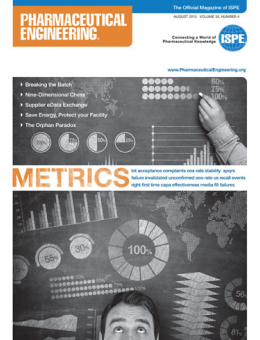
Downloads
Every Patient, Every Time
Cover: by Andrew D. Skibo, Head of Global Biologics Operations & Global Engineering, MedImmune/AstraZeneca, and Chairman of the Board of Directors, ISPE
Innovative Manufacturing Promotes Quality
Guest Editorial: by Juan Andres, Head Pharma Tech Ops, Novartis Pharma AG
Scientific and Regulatory Considerations For Implementing Mathematical Models In The Quality By Design (QbD) Framework (Part 2 of 2)
by Theodora Kourti, John Lepore, Lorenz Liesum, Moheb Nasr, Sharmista Chatterjee, Christine M.V. Moore and Evdokia Korakianiti
This article is the second of a two-part series and presents points to consider for building and using models in the regulated pharmaceutical industry and offers examples of how models can play a part in the Quality by Design (QbD) framework.
Content Uniformity Discussions: Current USP <905> Developments Regarding <905> and a Comparison of Two Relevant Statistical Approaches to Assess Content Uniformity
by James Bergum, William Brown, Jon Clark, Thomas Parks, Thomas Garcia, James Prescott, Charles Hoiberg, Sami Patel, and Ravindra Tejwani
Compare the performance of two statistical approaches (tolerance interval and ASTM E2709/E2810) to assess dosage unit uniformity. The potential impact that the approaches can have on the USP <905> monograph is also discussed.
Single-Use Freeze-Thaw Systems: A Process in Transition for the Pharmaceutical Industry
by Adam Goldstein and Pietro Perrone, P.E.
Get up-to-date on the next area of development and innovation: bulk drug substance containers for the transportation/storage of APIs.
An Electronic Format for Data Exchange between Raw Material Suppliers and End Users Enables Superior Knowledge Management
by Ting Wang, Bryan Looze, Tony Wang, Duncan Low and Cenk Undey
This article presents a standard format for electronic data exchange between suppliers and end users in order to encourage superior knowledge management.
Tests on Rouging and Experiences Dealing with Rouging in Pharmaceutical Production (Part 3 of 3)
by Thomas Blitz, Ernst Felber, Robert Haas, Birgit Lorsbach, Andreas Marjoram, Roland Merkofer, Tobias Mueller, Nathalie Schuleit, Marc Vernier and Thomas Wellauer
Part 3 of this article describes test and practical experiences using different cleaning methods, discusses the influence of different derouging chemicals on stainless steel surfaces and gives a summary of the results and assessment.
A Structured Tool for SUT Implementation
by Carl Carlson
Acquaint yourself with a tool for proactive single-use technology (SUT) design review and implementation. The tool utilizes a failure mode and effects analysis and a single-use design template for systematic review and risk assessment of SUT biotechnology facilities.
Utilizing a Science-And Technology-Based Approach with Voltage Optimization to Save Energy and Protect Your Facility
by Dr. Alex Mardapittas and Sean O’Reilly
Learn how voltage optimization can significantly reduce energy costs, reduce electrical consumption (kWh), lower carbon emissions and extend the lifetime of equipment while at the same time protecting against harmful harmonics, transients and correct issues related to phase voltage imbalances.